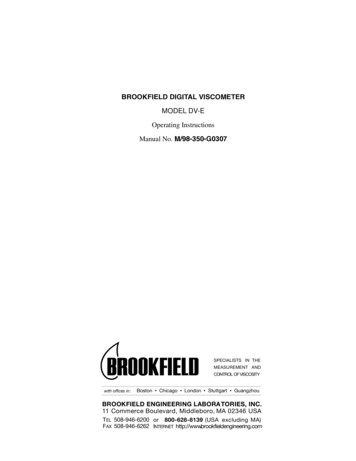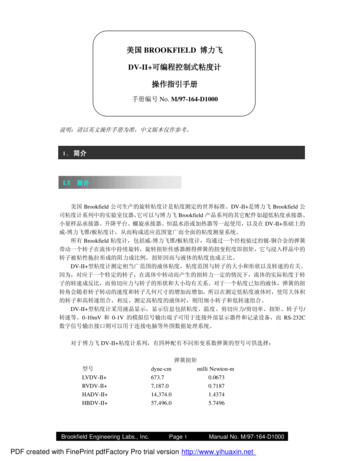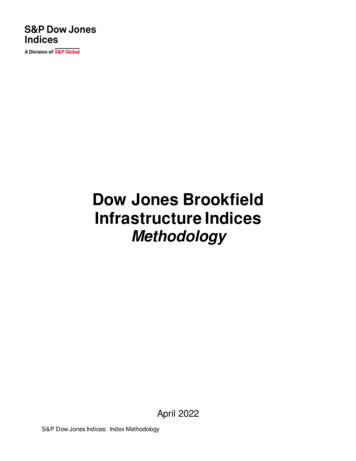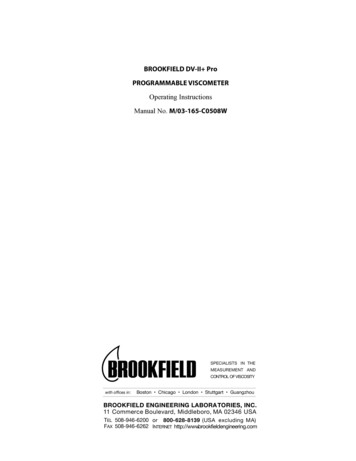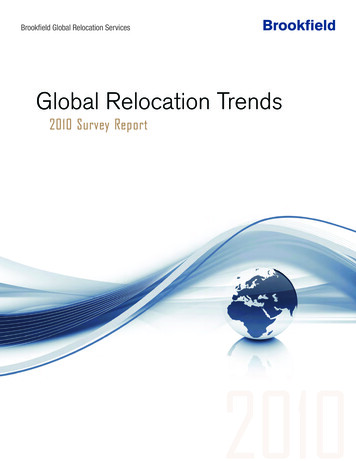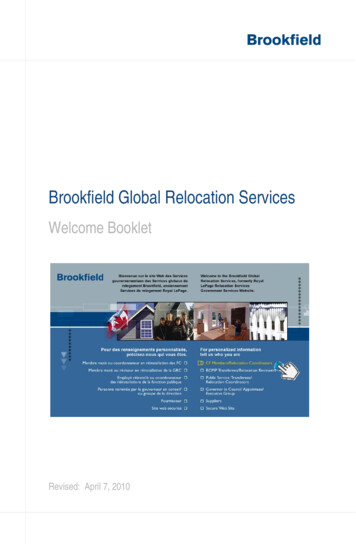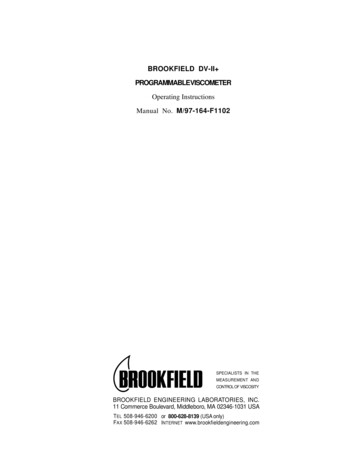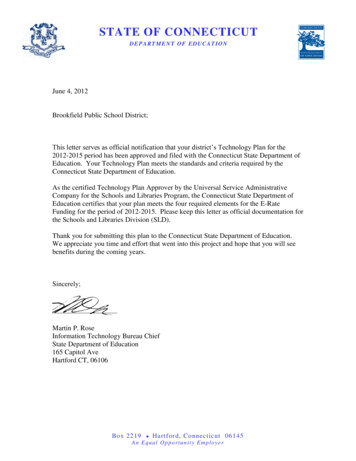
Transcription
STATE OF CONNECTICUTDE P A RTM E NT OF ED UC A TI ONJune 4, 2012Brookfield Public School District;This letter serves as official notification that your district’s Technology Plan for the2012-2015 period has been approved and filed with the Connecticut State Department ofEducation. Your Technology Plan meets the standards and criteria required by theConnecticut State Department of Education.As the certified Technology Plan Approver by the Universal Service AdministrativeCompany for the Schools and Libraries Program, the Connecticut State Department ofEducation certifies that your plan meets the four required elements for the E-RateFunding for the period of 2012-2015. Please keep this letter as official documentation forthe Schools and Libraries Division (SLD).Thank you for submitting this plan to the Connecticut State Department of Education.We appreciate you time and effort that went into this project and hope that you will seebenefits during the coming years.Sincerely;Martin P. RoseInformation Technology Bureau ChiefState Department of Education165 Capitol AveHartford CT, 06106Box 2219 Hartford, Connecticut 06145An Eq u a l Op p o rtu n ity E mp lo y er
CONNECTICUT STATE DEPARTMENT OF EDUCATIONEDUCATIONAL TECHNOLOGY PLAN TEMPLATEJuly 1, 2012 – June 30, 2015ED 616Section 254(h)(1)(B), of the Telecommunications Act of 1996, and FCC Order 97-157, Paragraph 573Elementary and Secondary Education Act (ESEA) 20 U.S.C. § 6777Published: August 2011Submissions to RESCs for review due by March 9, 2012Submission to CSDE due June 15, 2012
CONNECTICUT STATE DEPARTMENT OF EDUCATIONStefan PryorCommissioner of Education“The State of Connecticut Department of Education is committed to a policy of equal opportunity/affirmative actionfor all qualified persons. The Department of Education does not discriminate in any employment practice, educationprogram, or educational activity on the basis of race, color, religious creed, sex, age, national origin, ancestry,marital status, sexual orientation, disability (including, but not limited to, mental retardation, past or presenthistory of mental disability, physical disability or learning disability), genetic information, or any other basisprohibited by Connecticut state and/or federal nondiscrimination laws. The Department of Education does notunlawfully discriminate in employment and licensing against qualified persons with a prior criminal conviction.Inquiries regarding the Department of Education's nondiscrimination policies should be directed to: Levy Gillespie,Equal Employment Opportunity Director, Title IX/ADA/Section 504 Coordinator, State of Connecticut Department ofEducation, 25 Industrial Park Road, Middletown, Connecticut 06457, 860-807-2071.
Table of ContentsEDUCATIONAL TECHNOLOGY PLAN APPROVAL PROCESSCOVER PAGETECHNOLOGY PLAN PREPARATION CHECK-OFF PAGELOCAL EDUCATION AGENCY FEDERAL GRANT PROGRAM COMPLIANCE FORMLEA PROFILETechnology LiteracyPoliciesOnline AssessmentsTECHNOLOGY PLANNING COMMITTEEOverviewVISION STATEMENT (including Brookfield Public Schools strategic Plan)NEEDS ASSESSMENTCurriculum IntegrationProfessional DevelopmentEquitable Use of TechnologyInfrastructure and TelecommunicationsAdministrative NeedsPLAN IMPLEMENTATIONLEA Technology Goals and StrategiesGOAL 1: ENGAGING AND EMPOWERING LEARNING EXPERIENCESAction Plan for Goal 1 (including Brookfield Information & Technology Literacy Frameworks)GOAL 2: ASSESSMENTAction Plan for Goal 2GOAL 3: CONNECTED TEACHING AND LEARNINGAction Plan for Goal 3GOAL 4: INFRASTRUCTURE FOR TEACHING AND LEARNINGAction Plan for Goal 4GOAL 5: PRODUCTIVITY AND EFFICIENCYAction Plan for Goal 5Children’s Internet Protection Act (CIPA) CertificationOPTIONAL REPORTINGGrants and FundingAPPENDICESAppendix A: Tech Planning ResourcesTechnology PlanningAppendix B: Evaluating Your PlanThe CommitteeThe Mission StatementThe Needs AssessmentGoal 1.0 Engaging and Empowering Learning ExperiencesGoal 2.0 AssessmentGoal 3.0 Connected Teaching and LearningGoal 4.0 Infrastructure for Teaching and LearningGoal 5: Productivity and EfficiencyAppendix C: Technology Plan Review 48505053545459595960606060616162626364
EDUCATIONAL TECHNOLOGY PLAN APPROVAL PROCESSThe need for careful educational technology planning is as important as ever. The CSDE and RESC Alliancehave updated the technology plan template to reflect current school district needs and more closely align itto the National Technology Plan. Please read the technology plan process and refer to the evaluationsection that lists some of the elements of an exemplary plan. Your RESC contact is listed within the templateand is ready to help you plan if you require assistance.1. Technology Plan: Complete the plan using the template provided.2. RESC Review*: Send a draft of the completed plan as an email attachment to the RESC staff listedbelow for your RESC region. This person will be your contact for an initial review and will facilitatethe process. Please submit your initial draft by March 9, 2012 using the subject line “TechnologyPlan Submission”3. Revisions: Your RESC contact will review and provide recommendations. You must then completethese revisions by May 15, 2012.4. Superintendent/Director signature: Your plan needs to be signed by your superintendent ordirector on the three signature lines listed below.a. Technology Plan Preparation Check-Off Pageb. LEA Federal Grant Program Compliance Formc. Children’s Internet Protection Act (CIPA) Certification5. Board of Education Approval: Submit the plan to your local board for approval.6. Final Approval: Send the final copy, signed and board approved to your RESC contact. Send one (1)hard copy and an electronic file on CD before June 15, 2012.7. Final Check: The plan will be to be initialed by the RESC contact and forwarded to CSDE.8. Certification: Upon review and approval by the CSDE, a letter of state certification will be sent bythe CSDE to the LEA superintendent/director.* The RESC reviewer’s task is not to evaluate your technology plan but to check it for completeness andalignment with the template’s requirements.RESC herBobowick203-3658883CRECDoug Casey860-5244092EASTCONNJane -5670863AddressACES205 Skiff StreetHamden, CT 06517CES40 Lindeman DriveTrumbull, CT 06611CREC111 Charter OakAvenueHartford, CT 06106EASTCONN376 HartfordTurnpike Hampton,CT 06247Ed Connection355 Goshen nection.org
Litchfield, CT 06759LEARNVernaSodanoRichards860-4344800 ext.367LEARN44 Hatchetts HillRoadOld Lyme, CT 06371vsodano@learn.k12.ct.usCover PageEDUCATIONAL TECHNOLOGY PLAN – July 1, 2012-June 30, 2015District/Agency:BrookfieldLEA Code:018Technology Plan Contact:Arthur eya@brookfieldps.orgAddress:100 Pocono Road, Brookfield, CT 06804Name of Superintendent or Director:Anthony J. BivonaEmail:bivonat@brookfieldps.orgSignature of Superintendent or Director:Date:3/8/2012Date Submitted to Board of Education:3/8/2012Date Approved by Board of Education:3/8/2012For RESC/SDE Use Only:RESC Regional Reviewer:RESC Recommendation for Approval:CSDE Authorization:Date:Yes / No / ConditionalDate:Date:
Technology Plan Preparation Check-Off PageThe submitted plan has the following: Cover Page Technology Plan Preparation Check-Off Page LEA Federal Grant Program Compliance Form LEA Profile Technology Planning Committee Vision Statement Needs Assessment Goal 1 Goal 2 Goal 3 Goal 4 Goal 5 Children’s Internet Protection Act (CIPA) Certification Optional Reporting** The LEA is encouraged to complete a technology funding source list and budget to submit with thetechnology plan.Signature of Authorized LEA AgentDate
Local Education Agency (LEA) Federal Grant Program ComplianceFormLEA submitting this plan.Developing a comprehensive technology plan based on the educational goals of the school system willensure that the most appropriate technologies are effectively infused into your instructional and/oradministrative programs. Thorough planning also ensures that all parties have equitable access and achievethe greatest benefit from routine use of educational technology. The comprehensive technology plan shoulddemonstrate clear targets for technology use, spell out desired goals for learners, create visions for futuredirections, build "buy-in" from stakeholders, and demonstrate to those who might provide funding that adistrict or charter holder is ready to act.School districts, consortia or charter schools (LEAs) who apply for technology funding through any Federalgrant program are required to have developed a comprehensive, three-year plan, which outlines how theagency intends to utilize and integrate educational technology.The applying agency (check all that apply)Xis compliant with the provisions of the Children’s Internet Protection Act (CIPA) [20 U.S.C. §6777]will be CIPA compliant by thisdate.Xhas applied for E-Rate Funding.The LEA’s comprehensive technology plan must be approved by the local board of education.Date the plan wasapproved:ORDate the plan is to be submitted for boardapproval:Certified by:Signature of Superintendent or DirectorDatePrinted Name of Superintendent or Director8
LEA ProfileLEANAME:Brookfield Public SchoolsThis information should provide a “snapshot” of your district and help planners and reviewers to understandareas of need. This information will also assist the CSDE to establish priorities in the provision of resourcesto districts. The CSDE is particularly interested in the capability that each LEA has to access resources thatwill be placed onto the Connecticut Education Network (CEN). The new questions about technologicalliteracy and professional development are asked as a result of additional federal reporting requirements.Technology LiteracyQuestionsYourDistrict’sNumbersHow many Grade 8 students were evaluated for technological literacy, based on your district'sstandards, during the 2010-11 school year?212Based on that evaluation, how many of those students were considered technologically literate?How many hours of technology related professional development were offered to certifiededucators in 2010 -11? (Include workshop hours that are offered to all of your educators-bothteachers and administrators. These sessions may be online and may include full-day or partialday sessions provided by RESC personnel. Although both mentoring and coaching areconsidered very effective methods of offering pd, do not include any of those hours.)How many hours of technology related professional development were offered to administratorsin 2010-11? (Count only those pd hours offered specifically for administrators.)What fraction of your certified staff in Grades K-8 does your district consider technologicallyliterate? (Do not reduce the fraction to lowest terms; the fraction’s denominator should reflectthe actual number of professional K-8 staff. For example, if out of 120 certified staff, 110 areconsidered technologically literate-the answer would be 110/120. )What fraction of your certified staff in Grades 9-12 does your district consider technologicallyliterate? (Do not reduce the fraction to lowest term. The fraction’s denominator should reflectthe actual number of professional 9-12 staff.)2129310114/15260/73PoliciesHow often are your Acceptable Use Policy and other technology-related policies updated (Please check onebelow)?Every yearEvery other yearAt least every three yearsOther:Insert a link to your district’s AUP below if it is stored on the load9
Online AssessmentsWhen filling out the table below, please consider the following conditions: the number and percentage of each grade level of students that can have high-speed internet accessat the same time; that students are grouped in clusters of no more than thirty and no less than ten; and that students remain in their own school.Maximum number of Grade 4 students who could be accommodated under the above conditions.100Percentage of Grade 4 students who could be accommodated under the above conditions(number accommodated/total number of Grade 4 students).58%Maximum number of Grade 6 students who could be accommodated under the above conditions.125Percentage of Grade 6 students who could be accommodated under the above conditions(number accommodated/total number of Grade 6 students).60%Maximum number of Grade 8 students who could be accommodated under these conditions.125Percentage of Grade 8 students who could be accommodated under the above conditions(number accommodated/total number of Grade 8 students).Maximum number of Grade 10 students who could be accommodated under the aboveconditions.Percentage of Grade 10 students who could be accommodated under the above conditions(number accommodated/total number of Grade 10 students).1059%237100%
TECHNOLOGY PLANNING COMMITTEEThe Technology Planning Committee should represent all stakeholders. Development of the technologyplan and implementation of the plan should enable parents, educators, students and community membersto benefit from the investment in technology and all should have representation on the committee.MemberTitleConstituency RepresentedArthur ColleyDirector ofBusiness andTechnologyOperationsDistrictDr. Genie SloneDistrictJoe PalumboAssistantSuperintendentTechnology ResourceTeacherLibrary MediaSpecialistPrincipalDeane RendaPrincipalWMSMary Rose DymondPrincipalHHESCarrie KilianPrincipalCESMaureen FitzPatrickHHESDenise WalshLibrary MediaSpecialistLibrary MediaSpecialistTechnology StaffKathy ColavitoTechnology StaffDistrict, ParentTracy TishionJoyce ZaldoAllen BrosiousBHS, WMS, HHES, CESCESBHSWMSDistrict, ParentThe Committee must:o write a description of the technology committee’s role in developing, implementing and evaluatingthe technology plan. This description should include how committee members were selected and therole each is expected to play. Tentative plans for scheduling meetings for the next school year shouldalso be included;o describe the evaluation strategies (e.g., interviews, questionnaires, classroom observations, teacherdriven action research projects, analysis of student products or scores) that will be used to providethe data needed to address your evaluation questions;o create the LEA’s technology vision statement; ando develop a technology needs assessment.11
OVERVIEWThe Brookfield Board Of Education formed a Technology Advisory Committee in 1993 comprised ofeducational staff members from various grade levels and disciplines, members of the Board ofEducation, and town residents to develop a plan to increase student learning through theintegration and coordination of technology in the Brookfield Public Schools. By 1994, theTechnology Advisory Committee recommended an investment of time and money to obtain adistrict-wide faculty use survey, an inventory and needs assessment, a cost estimate of hardwareand infrastructure, and to hire a Director of Business and Technology Operations. In 1995, theBoard of Education provisionally accepted a Technology Plan. In 1996, a committee of teachers andlocal community experts convened to revise the plan and align it to the guidelines set by the state.That committee worked from spring until fall when a draft was brought to some communitymembers for their comments. Their critique formed the basis for changes leading to the final draftwhich was approved by the Board of Education in December 1996. This document has been revisedseveral times to reflect the transition of technology in the Brookfield Public Schools. Most recently,a committee of students, staff, community members, and administrators formed to write studentand staff technology competencies and begin a Professional Development plan.The purpose of Brookfield’s comprehensive technology plan is to improve student learning byproviding technology that can be accessed and used by all members of the school community. TheTechnology Plan details the goals and actions needed to enhance student learning through anintegration of technology with curriculum and instruction, full funding and implementation of theTechnology Learning Environments, professional development, and community awareness andeducation. Goals and action plans have been designed as a guide for the Brookfield staff to assistthem with the integration of multiple technologies in the appropriate program areas across theschool district. In addition, the plans provide for access to technology by all members of thecommunity. Each action plan includes objectives, responsible persons or groups, benchmarks andtimelines. The progress of the implementation of the technology plan will be monitored usingthese action plans.Technology must be integrated into all areas of the curriculum to achieve its full promise. Atechnology rich learning environment will enable all students to reach their potential, to developskills required by the workforce, and to be responsible citizens and lifelong learners. To this end,Brookfield’s Technology Plan calls for the replication of Technology Learning Environments (TLE) ateach of the district’s four schools and at the Alternative School. The TLEs will bring technology tostudents in their classrooms as well as provide instructional support in all media centers. The TLEsin every school will have the same core technology and a common baseline of software. Replicatingone model at each school provides equitable access and equitable distribution of resources. Duringthe 2007-2008 school year, a subcommittee, composed of library media specialists, the technologyresource teacher, and classroom teachers created the Brookfield Information and TechnologyLiteracy Framework (ITLF). This framework is used by each curriculum area to infuse technologyinto their units.Continuing to assist teachers in the use of technology in the classroom may be the most importantstep to assuring maximum impact. The professional development design of the Technology Planillustrates Brookfield’s commitment to increasing the skills and knowledge of all staff to fullyintegrate technology into instruction and into the operation of the schools. Providing interactive12
whiteboard technology was the focus during 2008-2009. This technology continues to be used inclassrooms throughout the district. Addressing growing portability between home and school, andat the same time maximizing software dollars, has led the committee to explore and begin usingopen source and Web 2.0 applications.During the 2010-2011 school year, the district adopted the use of Google Apps as the platform forcommunication and productivity tools. The library media centers began using Opals open sourcemanagement software. Teachers are transitioning to using web based tools and resources withtheir students. Staff, students, and the community now have access to the WIFI district wide. In the2011-2012 school year, iPads were provided to all ninth grade students and teachers.A subcommittee of the District Technology committee meets quarterly each year to monitor anddiscuss the district’s progress. The committee also has input into the composition of the next year’sbudget plan. Any projects that impact the majority of the staff are brought forth to this committeeto discuss implementation and roll out. This committee has been crucial to the success oftechnology in Brookfield. It is the continued participation in this group that will promote progressin the Brookfield Public School System.VISION STATEMENTA VISION OF TECHNOLOGY IN BROOKFIELD SCHOOLSAll members of the Brookfield Public School education community benefit from the use andintegration of technology within the schools. As a result of the use of technology, all students haveincreased capacity to actively participate in the learning process, solve problems, and becomelifelong learners and contributing members of a global community.Brookfield students will face significantly different and more complex challenges in the21st century than students have in the past. The nature of the information age and ourrapidly changing global economy demand higher level thinking skills, and knowledge ofinformation retrieval, science, math, and communications. The society of tomorrow willdemand that our students are critical communicators. The society of tomorrow will demandthat our students are critical thinkers and problem solvers. In addition, our students will needto engage in learning practices that lead to new ways of thinking, understanding andconstructing knowledge and communication results. The effective integration of technologyin our schools will provide the learning environment that will assist students in attainingthese higher level skills and behaviors. In both instructional and administrative settings, theappropriate selection and configuration of software and hardware resources will enhance thequality of the teaching/learning process and the management of related information.Technology will be seamlessly integrated into all aspects of every student’s educational experience.In this way, students will engage and interact with the tools and resources of the 21st century.Technology has the power to change teaching and learning. It provides the teacher with theopportunity to guide a child’s learning and exploration while addressing different learning stylesand individualizing instruction. With well-planned activities, the students will develop higher levelthinking skills as they are asked to look critically at information to evaluate its usefulness. With the13
availability of information, students can work purposefully to solve real life problems. Teachers andstaff members will have the tools to go beyond the walls of the school to gather resources andinformation and then use available multimedia tools to enhance their professional presentations tostudents.Technology will encourage excellence in our schools by maintaining a positive relationshipthrough communication with parents, employers and community members. A key element tothis communication between home and school is a presence on the Internet. A district web pageprovides information about our mission and goals to incoming families as well as timelyinformation on events and schedules for all community members. Our web site gives parents anopportunity to see some of the exciting projects and class work in which our students and facultyare involved.Technology will be a vehicle to strengthen home school relationships through communication.Individual classroom web pages and email provide parents with the important links totracking their child’s progress, keep parents up to date with classroom events, and promoteeffective communication between parent and teacher.Technology will provide a way for all students and all teachers to communicate and collaborateglobally. The Internet provides a way for teachers to collaborate with their peers in other parts ofthe world. Internet access will give students the ability to stretch beyond the walls of theirclassroom, to share activities, and to become partners in learning with other cultures.14
Brookfield Public Schools Strategic Plan 2010-2015Core ValuesComprehensive Education: We hold as a value that the district will provide an educational programthat spans a wide range of curricula that can accommodate all children in meeting their educational needs.Safety: We hold as a value that all students and staff and other members of the school community willwork in an environment that secures their physical and emotional well being.Life-Long Learning: We hold as a value that all students will be taught the necessary skills and receivethe encouragement to be active and inquisitive learners throughout their lives.Citizenship: We hold as a value that all students will be taught that the obligations they have as citizens isto fulfill their civic responsibilities to their community, state, and nation.Respect: We hold as a value that all students will hold themselves in high esteem and treat all others asthey wish to be treated.Continuous Improvement: We hold as a value that all students and staff will continue to growthrough ongoing experiences that fulfill their needs and enrich their knowledge.Rigor: We hold as a value that all students will be challenged with a comprehensive array of high qualityprograms that enables them to expand the limits of their abilities.Communication: We hold as a value that all students will be taught and encouraged to articulatethoughts and ideas using oral, written, and non-verbal communication in a variety of forms and contextsintegrating the array of communication resources available to them.Responsibility: We hold as a value that all students and staff will be accountable for their decisions andtheir actions.Integrity: We hold as a value that all students and staff will demonstrate an adherence to moral andethical principles rooted in a sense of honesty and truthfulness.Collaboration: We hold as a value that all students and staff will work effectively and respectfully withone another in groups to achieve common goals.15
Goal I: Student SuccessObjective Areas: 2010-2015Curriculum: Curriculum in the Brookfield Public Schools will be standards-based, rigorous,comprehensive, and transformational in order to prepare students for success in the 21st century.Indicators: Update K-12 curricula to align with National Common Core State Standards. Develop, refine and integrate the K-12 music curriculum to ensure that is challenging to allstudents at all levels of learning. Develop, refine and integrate the World Language Program to ensure that is challenging toall students at all levels of learning.Assessment: Assessment in the Brookfield Public Schools will foster continuous improvement, be datadriven and inform teaching and learning through the use of common formative assessments.Indicators: Improve scores on state assessments in the top quartile of DRG (Demographic ReferenceGroup) B Establish and implement district and school-based data teams to improve studentachievement.Instruction: Instruction in the Brookfield Public Schools will be student-centered, collaborative, reflectiveof best practices, and technology-infused.Indicators: Increase the use of web-based/collaborative technologies in all subject areas byimplementing Web 2.0 Implement “scientifically research-based interventions” [SRBI] driven by assessmentidentified needs. Integrate 21st century skills into teaching and learning to better prepare students for realworld challenges. Develop, refine and integrate the special education and student support services programsto meet the diverse needs of all students to ensure their success.Professional Development: Professional development in the Brookfield Public Schools will besystemic, goal-driven; results oriented and meet the needs of the professional learning community.Indicators: Provide staff with opportunities to learn and share best practices of instruction andencourage innovation and teacher creativity through the use of results-driven professionaldevelopment. Provide staff with opportunities to integrate 21st century skills into teaching to preparestudents to live and work in a changing world.16
Foster opportunities to develop teacher leaders through an administrative aspirantprogram.Recognizing Success: “Recognizing” success in the Brookfield Public Schools will celebrate innovation,effort, and achievement, while fostering risk-taking to improve teaching and learning.Indicators: Inform the community about students’ achievement and staff accomplishments to inspireexcellence and communicate our district successes.17
Goal II: Student WellnessObjective Areas: 2010-2015Safe & Secure Learning Environment: A safe and secure learning environment in the BrookfieldPublic Schools will ensure a secure school environment and maintenance of class size guidelines.Indicators: Ensure the safety of all students and staff through the implementation of the district’scomprehensive safety plan. Ensure the viability of district facilities through the implementation of a long-term capitalimprovement plan.Character Development: character development in the Brookfield Public Schools will reflect acomprehensive developmental guidance and advisor-advisee programs and offer a broad range of cocurricular activities.Indicators: Provide co-curricular opportunities for students to accommodate and enrich the diversearray of their interests. Implement a developmental guidance program in grades 5-12 to support students’academic, social/emotional and vocational needs. Develop and promote mentoring opportunities for students to motivate and supportstudents. Assess and implement anti-bullying, cyber-bullying and character education programs toensure that students demonstrate respect for themselves and others.Physical & Emotional Health: To insure physical and emotional health, the Brookfield Public Schoolswill implement substance abuse prevention and healthy eating and exercise programs and initiatives tosupport at-risk students.Indicators: Coordinate with community organizations to implement prevention programs targetingsubstance abuse and other at-risk behaviors to reduce these high-risk activities. Advocate healthy life-style choices to foster physical and emotional well-being.Parent & Community Partnership: Parent and community partnerships in the Brookfield PublicSchools will increase opportunities for parent and community involvement and foster community support byactively communicating through technology, and partnering with community organizations.Indicators: Develop and implement a comprehensive plan for the engagement of the entire communityin school district activities. Garner community s
to the National Technology Plan. Please read the technology plan process and refer to the evaluation section that lists some of the elements of an exemplary plan. Your RESC contact is listed within the template and is ready to help you plan if you require assistance. 1. Technology Plan: Complete the plan using the template provided. 2.
